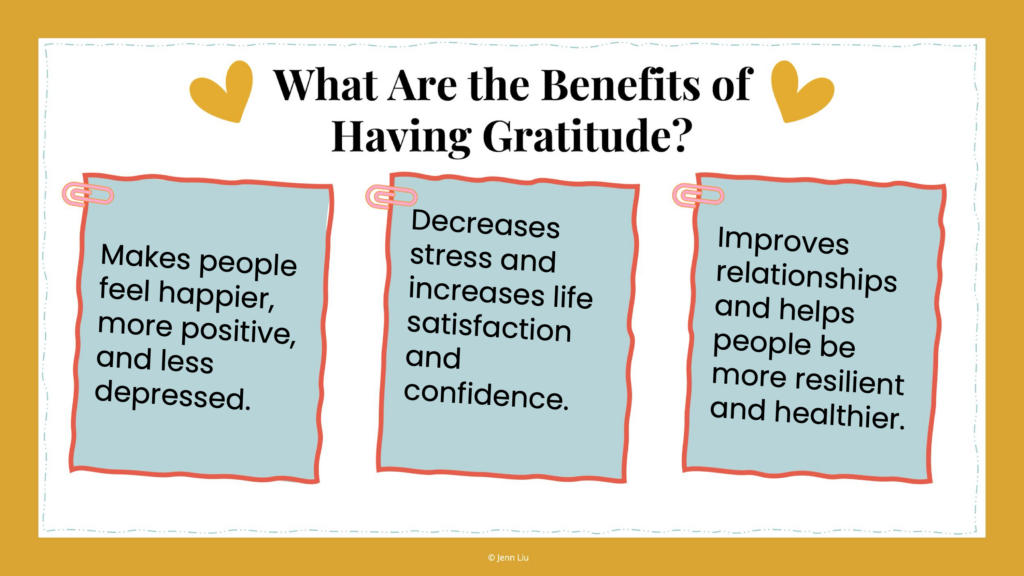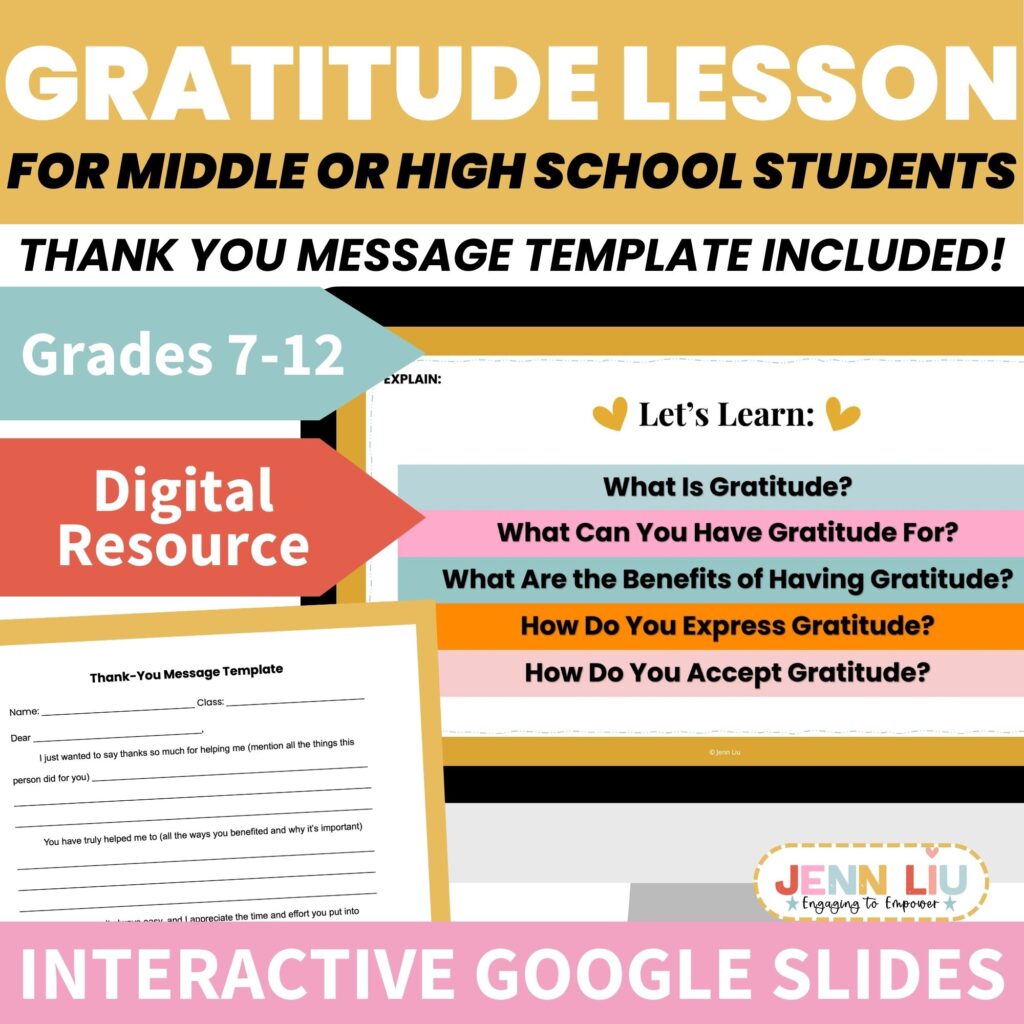Do you hear that?
Your breath of relief because Johnny [or insert your challenging student’s name] didn’t walk into class complaining again.
The sound of silence as your students take a deep breath, feel their toes on the ground, and focus on being present and grateful.
The clicks of keyboards as kids you barely recognize anymore thoughtfully complete an entry in their digital gratitude journals.
Amazing! Just what did “future you” do to make this happen?
You began teaching gratitude. Duh!
While teachers often think about teaching gratitude to students around Thanksgiving or Christmas (wanting to respect cultural differences during the holidays, gratitude is the one thing they can teach), gratitude can be taught at any time of the year. It’s never too late, but the beginning of the year would be best.
(Side note: I think it’s okay to talk about the holidays; just be sure to respect all students in your classes and do some research so they get the whole story about holidays such as Thanksgiving)

Indeed, the benefits of teaching gratitude are endless! I’m sure you don’t need to be convinced of all the good reasons to teach gratitude, but sometimes we need reminders when we feel at a loss as we’re struggling with teaching kids who might often seem anxious, defiant, or more interested in social media than our lesson.
Granted, many factors causing these feelings are beyond your students’ control, but they can manage how they respond.
Teaching gratitude can be a great solution! So here are your reminders:
Teaching students to be grateful can…
- Replace a culture of complaint, materialism, and entitlement with gratitude and appreciation, including an appreciation of their education.
- Create a positive classroom culture with better student behavior and relationships.
- Help students to be more mindful and present.
- Improve students’ relationships with each other.
- Enhance students’ spiritual and emotional well-being.
- Build and instill resilience in students.
- Reduce stress and anxiety in students.
- Increase students’ motivation to succeed.
- Prevent students from burnout.
- Encourage students to give back.
- Get parents to appreciate you more when they learn you helped their child to be more grateful.

Are you ready for some ideas on how to teach gratitude? Be sure to read to the end for bonus tips!
1. Teach what gratitude is:
A positive feeling of being thankful and appreciative; the ability to recognize and acknowledge good things, people, and places in our lives; mindful thankfulness, even when things are difficult.
Tip: Ask your students to think about what they’re thankful for and then ask: “How did that make your feel? How did your body respond? Did your attitude change?”
2. Discuss what we can have gratitude for. This can include:
- People who have helped you, especially when it was intentional and benefited you
- Places and nature
- Ideas, feelings, and experiences
- Relationships
Tip: Get your students into the practice of expressing gratitude by giving a daily or weekly gratitude journal assignment.
3. Review the benefits of having gratitude:
- Makes people feel happier, more positive, and less depressed.
- Decreases stress and increases life satisfaction and self-confidence.
- Improves relationships and helps people be more resilient and healthier.
Tip: Remind your students that…
- Studies find that people who keep a gratitude journal have more life satisfaction, sleep better, and have lower stress hormones.
- Gratitude is a choice. You can focus on the good or bad things in life. You can lift others up or bring them down.
4. Brainstorm ways we can express gratitude to a person:
- Write a letter or make a card.
- Leave a surprise note.
- Send a text or say it face-to-face.
- Give a gift.
Tip: Give your students an idea of what to say to express gratitude. Here is a simple sequence they can follow:
“Thanks so much for helping me…” (what the person did)
“This truly has helped me to…” (how you benefited or improved)
“I realize that you had to…” (what the person had to give up or sacrifice, e.g., time)
“I feel…” (how you feel about the person)
5. Share ways we can practice gratitude daily:
- Give thanks every morning and night.
- Keep a gratitude journal.
- Lift others up regularly.
- Always focus on the positive.
Tip: Discuss how people might express gratitude differently depending on their culture and to who they’re showing gratitude.
If you would like a done-for-you Google Slides lesson to help you teach all of the above, click HERE! This lesson also includes discussion questions and an editable activity choice board, with these options:
- Make a list of 25 things you are grateful for.
- Start a gratitude journal and write at least one paragraph in it every day for the next five days.
- Make a plan with 10 things the people in your family can do to be more grateful.
- Write a thank-you letter or make a thank-you card for one of your teachers. (This last activity includes a link to a Google Doc with a thank-you message template)

Bonus tips (i.e., how to improve your classroom culture):
As with anything we want students to learn, modeling is the best way to teach it. If you don’t already do this, make it a practice to thank students when they help you or a classmate, work extra hard, listen attentively, show initiative, take a risk, or do anything you think is worthy of praise–whether big or small.
You can also share what you are thankful for. For example, on a cold morning, you might say, “I’m so thankful for this warm cup of coffee.” Or on a hot day you could say, “We’re so lucky to have cold AC in this class. I remember a few years ago when we didn’t.”
I also like to end class by thanking everyone for trying their best, working hard, and being kind to each other. Another thing you could do is post notes of gratitude to a wall or collect them in a jar for reading at the end of each class.
Finally, you could devote a day to gratitude, either through journal writing or a class activity. In my class, Thursday is “Thoughtful Thursday,” a day for thinking of others. You could even make it “Thankful Thursday”!
Some things we have done on our Thoughtful Thursdays are: write kind messages to each other, make gifts with thank you notes for our school support staff, make a list of what we love about our school, and plan school and community service projects.
I’m sure you and/or your class could come up with some great ideas! Friendship bracelets anyone?
If you enjoyed this article, share it with your teacher friends and colleagues!
Bold font